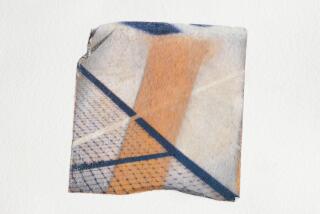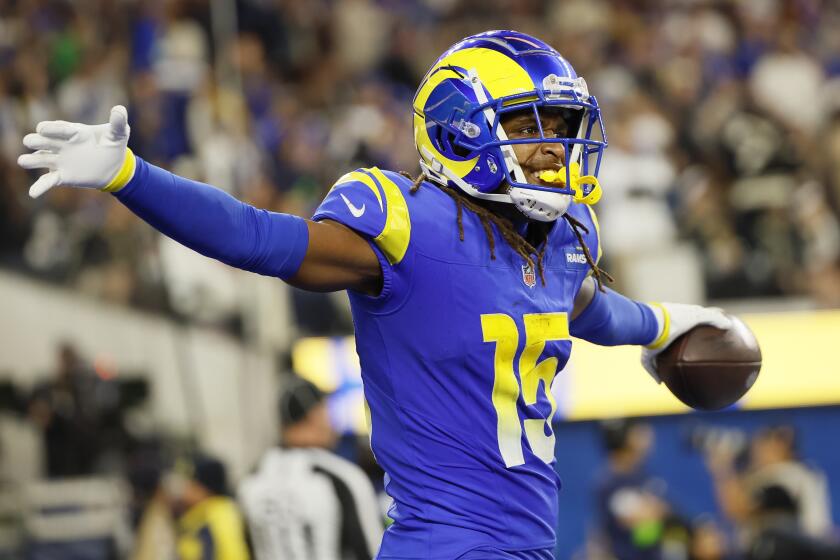Arthur Ashe, Champion on and Off Court, Dies of AIDS : Sports: Only African-American man to win Wimbledon and U.S. Open also pushed for human rights.
Arthur Ashe, who gained world attention with his battles on the tennis court and his struggles for human rights and against AIDS, lost his fight with the disease Saturday afternoon.
Ashe was 49 and died of pneumonia, a complication of AIDS, said New York Hospital administrator Judith Lilavois.
âAn additional statement will come from his family and the hospital (today),â she said.
Ashe said he had contracted the human immunodeficiency virus from an unscreened blood transfusion in 1983 during his second open heart surgery.
He went public in April with the news that he had the disease after learning that a newspaper planned to release the information.
Among those reacting to Asheâs death Saturday was former Los Angeles Lakers star Magic Johnson, who was forced to retire from basketball after he tested HIV-positive.
âArthur Asheâs passing away makes this a very sad day, not only for the world of sports but the entire world in general,â said Johnson. âNot only was Arthur a leading figure and pioneer for minorities in sports and business, but also in the fight against HIV and AIDS. He was one of the best men of his generation, and his loss is a loss for all of us.
âIf one can look for hope, however, on this very sad occasion, it is that this is yet another compelling reminder of just how important it is to find a cure for this horrible disease.â
The only black man to win the Wimbledon championship and the U.S. Open, Ashe faced his condition with all the tenacity he had displayed on the court. Shortly after his announcement, Ashe founded the Arthur Ashe Foundation for the Defeat of AIDS. He also joined the boards of the Harvard AIDS Institute and the UCLA AIDS Institute.
âTonight, I have lost a very dear and very loving friend, Arthur Ashe,â New York Mayor David N. Dinkins said in a statement. âSimply put, words cannot suffice to capture a career as glorious, a life so fully lived, or a commitment to justice as firm and as fair as was his. Nor can words suffice to capture the sense of loss I feel in knowing he is no longer among us.â
There was genuine shock at Asheâs passing because there had been no public acknowledgment that his condition had worsened.
âI saw him not too long ago,â said tennis player Tim Mayotte, âand he was talking about how well he was feeling. I certainly wasnât prepared for this to happen.â
In a November interview, Ashe had stressed how well he was doing.
âIâm not sick,â he said. âMy blood test numbers are holding steady, and I think a lot of it has to do with personal initiative, in addition to what my doctors tell me to do.
âBut it does make planning tenuous. No question about that. I tend to plan no further ahead than in, say, three-month increments, because I would not want to be disappointed if I plan for something six months from now and Iâm not feeling very good.
âBut thatâs not to say that Iâm morbid about it. Iâm not in the least. Iâve lived with this now for four and one-half years, so you see you come to some accommodation with it. But professionally, I feel rather satisfied.â
There was plenty for Ashe to be satisfied with on the tennis court.
In addition to Wimbledon and the U.S. Open, Ashe won the World Championship Tennis Finals and was ranked among the worldâs top players in 1968 and 1975.
Ashe was born July 10, 1943, and grew up in Richmond, Va. His life as a tennis player began in a neighborhood park where his father worked as a security guard.
Asheâs mother died when he was 6, but he had two strong male figures in his formative years--his father, Arthur Sr., and Dr. Walter Johnson, a general practitioner from Lynchburg, Va., whose home was a haven for young tennis hopefuls.
Johnson was a firm believer in nonviolence, and he transferred that belief to young Ashe.
âIâm no crusader,â Ashe once said.
But he was, although he pushed for racial equality and human rights with the same firm but low-key style he demonstrated on the court.
He played the game with the best of his era, but he refused to play many of the mind games others employed to gain a psychological edge.
No boorish behavior for Ashe.
No volley of expletives.
No attacks upon the integrity of the linesmen.
Fortified with a blistering serve, Ashe arrived on the national scene with victories the 1960 and â61 indoor junior championships.
That led to a scholarship at UCLA, which he entered in 1961. He was not only the master of the courts on the Westwood campus, but their mender as well. Ashe was given a job taking care of the same courts he practiced and played on. Ashe won the NCAA singles and doubles titles and led the Bruins to the team championship in 1965.
In 1968, at age 25, Ashe burst on the international scene. He won the first U.S. Open as an amateur, was ranked among the leading players in the world and helped the United States overcome Australia for its first Davis Cup victory in five years.
Overall, Ashe played on Davis Cup squads for 10 years, had a 28-6 record and was on four winning teams.
He had a 106-28 lifetime mark in Grand Slam competition.
The early 1970s brought one triumph after another. Ashe won the 1970 Australian Open. He made four straight appearances in the World Championship Tennis Finals, climaxing with a 1975 victory over 19-year-old Bjorn Borg to win that prestigious event.
It was also in 1975 that Ashe enjoyed perhaps his most memorable win, beating Jimmy Connors--then the worldâs top-ranked player--6-1, 6-1, 5-7, 6-4, at Wimbledon.
The victory helped Ashe earn the top ranking in menâs tennis. It also marked the 10th time in as many years that he was listed among the worldâs top five.
Asheâs health problems began in 1977. He was forced to sit out most of that year because of a recurring heel injury and an eye inflammation problem.
His computer ranking had dropped to No. 257. Some questioned if perhaps his career was over at 34.
Not quite.
When his body healed, Ashe trained vigorously, returned to the tennis tour in 1978 and climbed back into the top 10 in less than a year. He was at No. 8 in 1979 when he suffered a heart attack. After surgery, he announced his retirement in 1980.
But then, at 38, he was named captain of the U.S. Davis Cup team, fulfilling a lifelong dream.
âWhen I was a kid, the three entities that meant the most to me were Forest Hills, Davis Cup and Pancho Gonzalez,â Ashe said. âI figured that one day my time might come to be named captain. Itâs something Iâve always wanted.â
So back Ashe came to lead the United States to triumph in 1981 and 1982. He captained the U.S. squad for three more years before his retirement in 1985.
That same year, he was inducted into the International Tennis Hall of Fame.
But Ashe never forgot his roots. Asked if he had an idol, he named longtime tennis great Gonzalez.
âHe was the only one whose skin was closest to mine,â Ashe said.
Gilbert Carter, a childhood friend, said Ashe was busy right up to the end.
âWe were all kind of hoping he had a little bit more time,â Carter said. âI know there were quite a few things he still felt he had to do.
âWe were trying to develop with him a black hall of fame to include all athletes from soccer, tennis, swimming--all sports. We talked and joked. And I can tell you for a fact, we were anticipating many, many more meetings.â
But it was not all joking for Ashe in his final months.
âHe had some bad moments, some bad days,â said Charlie Pasarell, Asheâs roommate at UCLA. âHe talked openly to me about it. I got used to seeing him in good and bad moments. I canât tell you how many times Iâve had that bad dream about this. I knew this day would come, but itâs so hard.â
The Associated Press contributed to this story.
RELATED STORIES, C1
More to Read
Go beyond the scoreboard
Get the latest on L.A.'s teams in the daily Sports Report newsletter.
You may occasionally receive promotional content from the Los Angeles Times.










